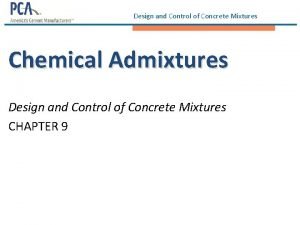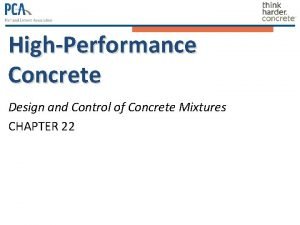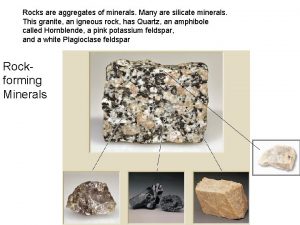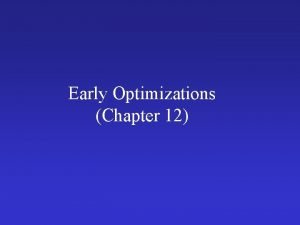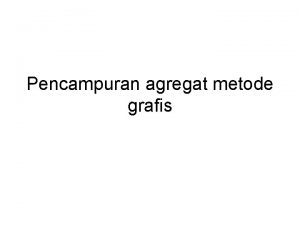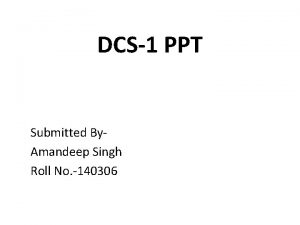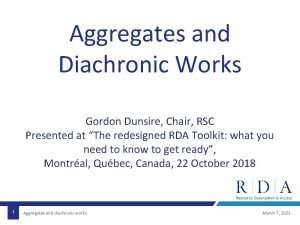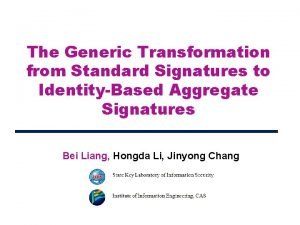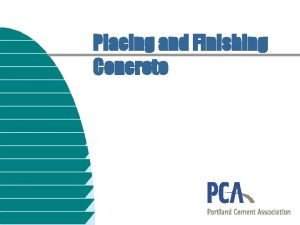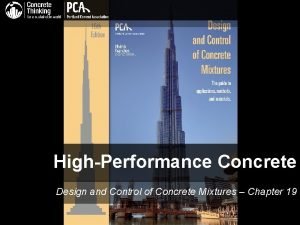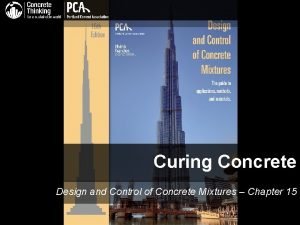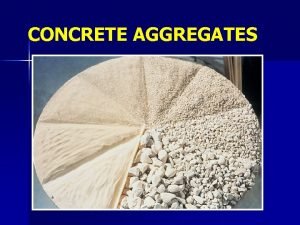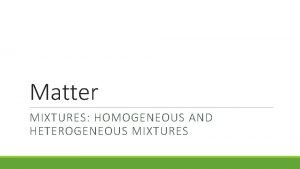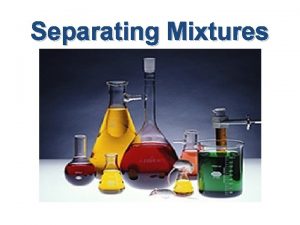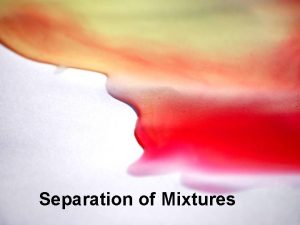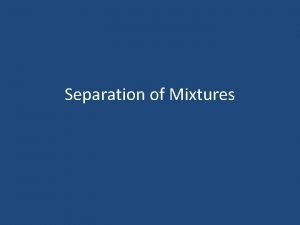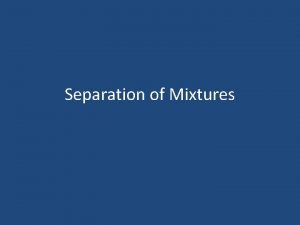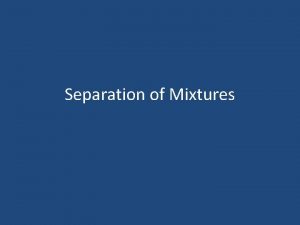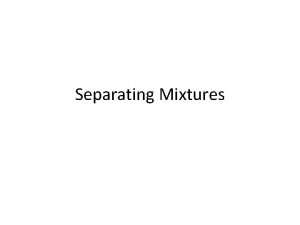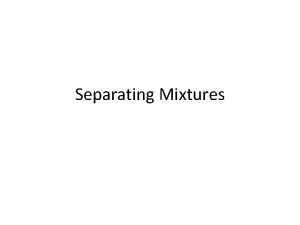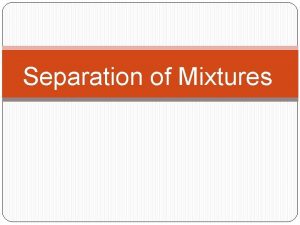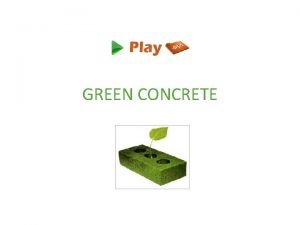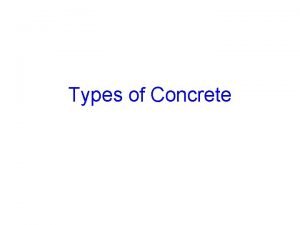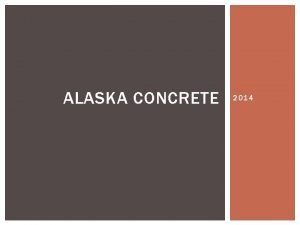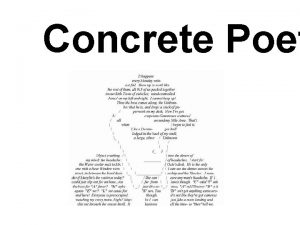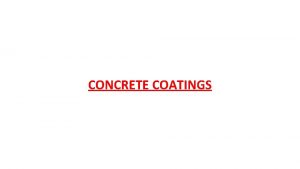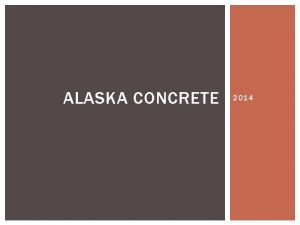Design and Control of Concrete Mixtures Aggregates for



















































- Slides: 51

Design and Control of Concrete Mixtures Aggregates for Concrete Design and Control of Concrete Mixtures CHAPTER 8

Design and Control of Concrete Mixtures Overview • • Aggregate Geology Aggregate Classification Characteristics of Aggregates Potentially Harmful Materials Alkali-Aggregate Reactivity Aggregate Beneficiations Handling and Storing Aggregates

Design and Control of Concrete Mixtures Aggregates of Concrete

Design and Control of Concrete Mixtures Aggregate Geology Rock and Mineral Constituents in Aggregates

Design and Control of Concrete Mixtures Aggregate Classification • Natural aggregate • Manufactured aggregate • Recycled-concrete aggregate • Marine-dredged aggregate

Design and Control of Concrete Mixtures Bulk Density • Normal weight concrete: 1200 kg/m 3 to 1750 kg/m 3 (75 lb/ft 3 to 110 lb/ft 3) • Lightweight concrete aggregates: 560 kg/m 3 to 1120 kg/m 3 (35 lb/ft 3 to 70 lb/ft 3) • Heavyweight aggregates: Typically over 2100 kg/m 3 (130 lb/ft 3)

Design and Control of Concrete Mixtures Natural Aggregate • Gravel and sand – Mixture of several minerals • Pits, rivers, lakes, seabeds • Quality depends on parent bedrock

Design and Control of Concrete Mixtures Manufactured Aggregate • Crushed rock or air-cooled slag – Fine and coarse aggregate • Rough, angular texture • Cubical or elongated shape • More uniform in size • Less likely to be contaminated

Design and Control of Concrete Mixtures Recycled-Concrete Aggregate

Design and Control of Concrete Mixtures Recycled-Concrete Aggregate

Design and Control of Concrete Mixtures Marine-Dredged Aggregate • • Tidal estuaries, seashore Two concerns: seashells and salt Avoid uncrushed shells Avoid using high chloride aggregates in reinforced concrete

Aggregate Characteristics and Tests of Aggregate

Aggregate Characteristics and Tests of Aggregate

Design and Control of Concrete Mixtures Grading

Design and Control of Concrete Mixtures Grading

Design and Control of Concrete Mixtures Grading Limits

Design and Control of Concrete Mixtures Fine-Aggregate Grading

Coarse-Aggregate Grading

Design and Control of Concrete Mixtures Coarse-Aggregate Grading

Design and Control of Concrete Mixtures Maximum Size vs. Nominal Maximum Size • Maximum size – 100% passing • Nominal maximum size – typically 85% to 95% passing

Design and Control of Concrete Mixtures Nominal Maximum Sizing Dmax = 1⁄5 B, ¾ S, ¾ C, 1⁄3 T

Design and Control of Concrete Mixtures Combined Aggregate Grading

Design and Control of Concrete Mixtures Combined Aggregate Grading

Design and Control of Concrete Mixtures Combined Aggregate Grading

Design and Control of Concrete Mixtures Workability Factor Shilstone 1990

Design and Control of Concrete Mixtures Tarantula Curve http: //www. optimizedgraded. com/

Design and Control of Concrete Mixtures Gap-Graded Aggregates • Certain particle sizes omitted, typically one coarse aggregate size • Excess coarse aggregate – honeycomb, segregate • Excess fine aggregate – high water demand, shrinkage • Properly proportioned mixtures are readily consolidated with vibration

Design and Control of Concrete Mixtures Fineness Modulus

Design and Control of Concrete Mixtures Particle Shape and Surface Texture

Design and Control of Concrete Mixtures Particle Shape and Surface Texture

Design and Control of Concrete Mixtures Bulk Density and Voids • Bulk density – mass of aggregate in unit volume – Includes voids • 30% - 45% voids in coarse aggregates • 40% - 50% voids in fine aggregates • Angularity increases voids

Design and Control of Concrete Mixtures Density and Relative Density • Density = Relative density x density of water – Typically between 2400 and 2900 kg/m 3 (150 and 181 lb/ft 3) • Relative density typically between 2. 4 and 2. 9

Design and Control of Concrete Mixtures Absorption and Surface Moisture

Design and Control of Concrete Mixtures Bulking

Design and Control of Concrete Mixtures Resistance to Freezing and Thawing

Design and Control of Concrete Mixtures D-Cracking

Design and Control of Concrete Mixtures Abrasion and Skid Resistance • ASTM C 131, Standard Test Method for Resistance to Degradation of Small-Size Coarse Aggregate by Abrasion and Impact in the Los Angeles Machine (AASHTO T 96) • ASTM C 535, Standard Test Method for Resistance to Degradation of Large-Size Coarse Aggregate by Abrasion and Impact in the Los Angeles Machine. • Siliceous content > 25% for good skid resistance

Design and Control of Concrete Mixtures Strength • Tensile strength – 2 MPa to 15 MPa (300 psi to 2300 psi) • Compressive strength – 65 MPa to 270 MPa (10, 000 psi to 40, 000 psi) • Rarely tested

Design and Control of Concrete Mixtures Shrinkage Characteristics of Aggregates

Design and Control of Concrete Mixtures Shrinkage Carlson 1938

Design and Control of Concrete Mixtures Fire Resistance and Thermal Properties • Dependent on mineral constituents • Lightweight aggregates outperform -weight aggregates • Calcareous aggregates outperform siliceous aggregates • Coefficient of thermal expansion – – 0. 55 x 10 -6 /°C to 5 x 10 -6 /°C (1 x 10 -6 /°F to 9 x 10 -6 /°F) normal

Potentially Harmful Materials

Design and Control of Concrete Mixtures Potentially Harmful Materials

Design and Control of Concrete Mixtures Potentially Harmful Materials

Design and Control of Concrete Mixtures Alkali-Silica Reaction Classification of aggregate reactivity ASTM C 1778, Standard Guide for Reducing the Risk of Deleterious Alkali-Aggregate Reaction in Concrete

Design and Control of Concrete Mixtures Alkali-Carbonate Reaction • Rare due to general unsuitability of reactive aggregates • Tested through: – Petrographic examination (ASTM C 295) – Rock cylinder method (ASTM C 586) – Concrete prism test (ASTM C 1105)

Design and Control of Concrete Mixtures Aggregate Beneficiation • Improving quality through processing – Heavy media separation – Jigging – Rising-current classification – Crushing

Design and Control of Concrete Mixtures Handling and Storing Aggregates

Design and Control of Concrete Mixtures Handling and Storing Aggregates

Design and Control of Concrete Mixtures Summary • • Geology Classification Characteristics of Aggregates Potentially Harmful Materials Alkali-Aggregate Reactivity Beneficiation Handling and Storage

Design and Control of Concrete Mixtures ?
 Air entrainment
Air entrainment Density of concrete
Density of concrete Rocks are aggregates of minerals
Rocks are aggregates of minerals Aggregate size
Aggregate size Sparse conditional constant propagation
Sparse conditional constant propagation Blending aggregates
Blending aggregates Grading of aggregates ppt
Grading of aggregates ppt Sieve analysis of fine aggregate ppt
Sieve analysis of fine aggregate ppt Gordon aggregates
Gordon aggregates Bleeding of concrete
Bleeding of concrete Ibas aggregates
Ibas aggregates Concrete semi concrete abstract
Concrete semi concrete abstract Concrete semi concrete abstract
Concrete semi concrete abstract Split range
Split range How far apart should expansion joints be in concrete
How far apart should expansion joints be in concrete Mixtures and solutions venn diagram
Mixtures and solutions venn diagram Kontinuitetshantering
Kontinuitetshantering Typiska novell drag
Typiska novell drag Nationell inriktning för artificiell intelligens
Nationell inriktning för artificiell intelligens Ekologiskt fotavtryck
Ekologiskt fotavtryck Varför kallas perioden 1918-1939 för mellankrigstiden
Varför kallas perioden 1918-1939 för mellankrigstiden En lathund för arbete med kontinuitetshantering
En lathund för arbete med kontinuitetshantering Särskild löneskatt för pensionskostnader
Särskild löneskatt för pensionskostnader Tidbok yrkesförare
Tidbok yrkesförare Sura för anatom
Sura för anatom Vad är densitet
Vad är densitet Datorkunskap för nybörjare
Datorkunskap för nybörjare Boverket ka
Boverket ka Debatt artikel mall
Debatt artikel mall Delegerande ledarstil
Delegerande ledarstil Nyckelkompetenser för livslångt lärande
Nyckelkompetenser för livslångt lärande Påbyggnader för flakfordon
Påbyggnader för flakfordon Arkimedes princip formel
Arkimedes princip formel Publik sektor
Publik sektor Kyssande vind analys
Kyssande vind analys Presentera för publik crossboss
Presentera för publik crossboss Argument för teckenspråk som minoritetsspråk
Argument för teckenspråk som minoritetsspråk Kanaans land
Kanaans land Treserva lathund
Treserva lathund Fimbrietratt
Fimbrietratt Claes martinsson
Claes martinsson Centrum för kunskap och säkerhet
Centrum för kunskap och säkerhet Programskede byggprocessen
Programskede byggprocessen Bra mat för unga idrottare
Bra mat för unga idrottare Verktyg för automatisering av utbetalningar
Verktyg för automatisering av utbetalningar Rutin för avvikelsehantering
Rutin för avvikelsehantering Smärtskolan kunskap för livet
Smärtskolan kunskap för livet Ministerstyre för och nackdelar
Ministerstyre för och nackdelar Tack för att ni har lyssnat
Tack för att ni har lyssnat Vad är referatmarkeringar
Vad är referatmarkeringar Redogör för vad psykologi är
Redogör för vad psykologi är Matematisk modellering eksempel
Matematisk modellering eksempel
